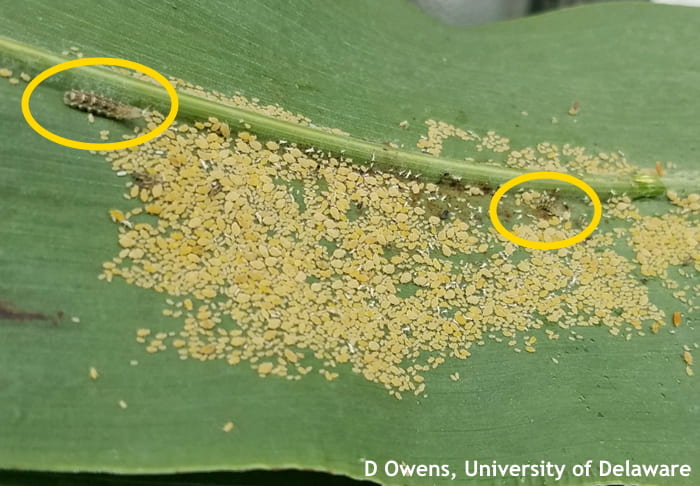David Owens, Extension Entomologist; owensd@udel.edu
Soybean
Our latest planted fields may still have active corn earworm (aka podworm) present, but for the most part, they are moving out of the system. That does not mean we can let down our guard. Soybean loopers are active, although their populations seem to be quite a bit lower this year than they were last year. Fields that were treated for earworms may have reduced beneficial insect activity. Also, late planted fields are at greater risk for late season stink bug infestation. Stink bugs developing in full season beans will move to more succulent, younger bean fields. Sweep thresholds are 5 bugs in 15 sweeps. The same is true for bean leaf beetle. Thresholds for bean leaf beetle are a bit trickier. Beetles need to be present in a field in fairly large numbers, and pod scarring approaching 10 – 15% before triggering a spray. All three late season pests, loopers, bugs, and beetles, will cause little injury to beans once they reach the R6.5 stage. While scouting for these pests, also pay attention to signs of Dectes stem borer. Fields with significant infestations should be prioritized for harvest as soon as possible to decrease risk of lodging losses. Please see this week’s Guess The Pest answer for more.
Sorghum
White sugarcane aphid, Melanaphis sacchari, has been detected in Delaware. This aphid made a host switch from sugarcane to sorghum and Johnson grass somewhere in Mexico or Texas in 2013. Since then, it has become one of the most important pests of sorghum in southern states. Here is a good fact sheet on aphid sampling and treatment decision making: https://cdn-ext.agnet.tamu.edu/wp-content/uploads/2016/03/sugarcane-aphid-guide-images.pdf. The aphids found in Delaware were isolated hot spots, widely separated in the field and natural enemies were working them over. The easiest aphid calling card to spot is honeydew, mostly present in the lower to mid-canopy. Aphids feed on phloem sap which is rich in sugars and low in amino acids. They filter and excrete the sugars which drop onto lower leaves, making them look slick. Sooty mold will grow on the honeydew, decreasing photosynthesis in the leaf tissue underneath.
Aphid honeydew on the top of a mid-canopy leaf. Note the black sheen on the leaf.
The offending aphid colony on the underside of the leaf above the one with honeydew. Circled are two syrphid maggots feeding on the aphids.
Another problem with these aphids in southern states, where they build up to phenomenally large numbers, is that they will migrate to the heads as the plant begins dying back or senescing. The honeydew and aphid bodies have been known to physically gum up combines. Below is an image of the honeydew excreted from a colony and the second image is of the offending colony, along with two syrphid maggots chowing down on this aphid colony. Other natural enemies present include lacewing larvae with their sickle-shaped jaws, lady beetle adults and larvae, and parasitoid wasps. Honeybees and adult flies can also be spotted feeding on the honeydew excretions.


